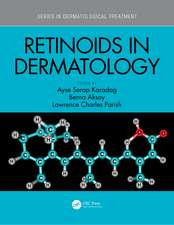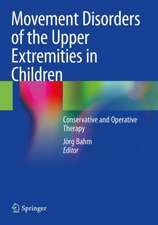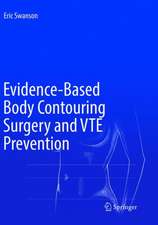Surgical Rationales in Functional Reconstructive Surgery of the Upper Extremity
Autor Jörg Bahmen Limba Engleză Hardback – 25 iul 2023
This book develops and describes surgical rationales in the field of reconstructive surgery for upper limb function, both in children and adults suffering from various diseases or trauma leading to a variety of motor and sensory impairments, sometimes associated with growth-related deformities. Every surgical career is a unique living story of learning, performing, questioning, trial and error, and finally success. Every surgeon has to integrate a wealth of information regarding ongoing clinical and research work in a range of disciplines; and with time and experience, a surgical rationale is developed that serves as a baseline and support for their day-to-day work.
Following a structure starting with the patient’s needs, the surgeon and the training, the different tissues are addressed and their pathophysiology discussed in detail, including basic research and surgical expertise. The book is not a surgical compendium, but instead focuses on the detailed baseline behind day-to-day clinical examinations, functional evaluations and surgical work. Readers will learn how the tissues interact, how pathologies change them and interfere with their functions, and how to reverse the pathophysiological sequence by surgical-technical means to improve function.
Although the book presents the author’s personal views, all aspects are explained and debated on the basis of past and current clinical findings, ongoing basic research and input from other disciplines: readers may disagree with certain points, but choose to implement some of the rationales and priorities, incorporate findings from fields they’d never previously explored, or investigate them further.
This book offers an extensive framework of argumentation and is intended to inspire and support readers in terms of decision-making and understanding current or uncommon procedures. Practitioners in the fields of peripheral nerve surgery, reconstructive plastic surgery, upper limb orthopedics, neuropediactrics, biomechanics, physiotherapy and ergotherapy will find the book a valuable asset, and a trusted companion in the daily quest to improve patient care!
Preț: 781.17 lei
Preț vechi: 822.29 lei
-5% Nou
Puncte Express: 1172
Preț estimativ în valută:
149.52€ • 162.47$ • 125.68£
149.52€ • 162.47$ • 125.68£
Carte disponibilă
Livrare economică 31 martie-14 aprilie
Preluare comenzi: 021 569.72.76
Specificații
ISBN-13: 9783031320040
ISBN-10: 3031320042
Pagini: 121
Ilustrații: X, 121 p. 47 illus., 40 illus. in color.
Dimensiuni: 178 x 254 mm
Greutate: 0.48 kg
Ediția:1st ed. 2023
Editura: Springer International Publishing
Colecția Springer
Locul publicării:Cham, Switzerland
ISBN-10: 3031320042
Pagini: 121
Ilustrații: X, 121 p. 47 illus., 40 illus. in color.
Dimensiuni: 178 x 254 mm
Greutate: 0.48 kg
Ediția:1st ed. 2023
Editura: Springer International Publishing
Colecția Springer
Locul publicării:Cham, Switzerland
Cuprins
Foreword.- 1. Decision Making in Reconstructive Surgery.- 2. Pre- and Postoperative Functional Evaluation in Reconstructive Surgery.- 3. Biomechanics and Physiology in Reconstructive Surgery of the Upper Limb.- 4. Invited Contributions – Fields Outside of My Work.- 5. Specific Peripheral Nerve Surgery for the Upper Limb.- 6. Working on Targets: Reconstructive Surgery of Muscles, Tendons, Joints, Bones.- 7. Growing Joints: Disbalance, Incongruence, Dysplasia.- 8. Postoperative Rehabilitation After Reconstructive Surgery - Interaction With Physio- and Occupational Therapists.- 9. Dialogue Between Surgical Clinics and Research: How Could We Share Projects And Strategic Directions?.- 10. Complications, Pitfalls, the Worst Case: How We Learn From Our Mistakes in Reconstructive Surgery.- 11. Continuity in Surgical Education.- 12. Conclusions.- 13. General References.
Notă biografică
Dr. Bahm received his medical degree in 1987 and completed his surgical training in France, Belgium and Germany. He trained in Hand Surgery in Lille, Strasbourg and Paris. He finished his surgical training at the University Hospital Aachen, Germany in 1995, and then worked as assistant physician at the Department of Plastic and Reconstructive Surgery, University Hospital Aachen, Germany, from 1994 to 2000. Dr. Bahm received his degree in Plastic Surgery in 1998 and in Hand Surgery in 2001. Since 2000, he has been head of the Unit for Reconstructive Microsurgery and Hand Surgery at Franziskus Hospital in Aachen, Germany before becoming in 2020 head of the section for Plexus Surgery within the Department of Plastic, Hand and Burn surgery at the University Hospital Aachen. Since 2007, he has also been a consultant for peripheral nerve surgery at the Department of Orthopaedics and Traumatology, Erasmus University Hospital in Brussels, Belgium. In 2011, he completed his Ph.D. in Medicine at the Faculty of Medicine, ULB University of Brussels, Belgium. His main research interest is in reconstructive plastic surgery in children, in particular for brachial plexus lesions. Dr. Bahm is a member of the German Society of Plastic, Reconstructive and Aesthetic Surgeons (DGPRÄC) and the German Society of Hand Surgeons (DGH), and was president of the Belgian Society of Hand Surgeons (BHG) in 2013. He has authored or co-authored more than 50 scientific publications in journals and books and authored two books.
Textul de pe ultima copertă
This book develops and describes surgical rationales in the field of reconstructive surgery for upper limb function, both in children and adults suffering from various diseases or trauma leading to a variety of motor and sensory impairments, sometimes associated with growth-related deformities. Every surgical career is a unique living story of learning, performing, questioning, trial and error, and finally success. Every surgeon has to integrate a wealth of information regarding ongoing clinical and research work in a range of disciplines; and with time and experience, a surgical rationale is developed that serves as a baseline and support for their day-to-day work.
Following a structure starting with the patient’s needs, the surgeon and the training, the different tissues are addressed and their pathophysiology discussed in detail, including basic research and surgical expertise. The book is not a surgical compendium, but instead focuses on the detailed baseline behind day-to-day clinical examinations, functional evaluations and surgical work. Readers will learn how the tissues interact, how pathologies change them and interfere with their functions, and how to reverse the pathophysiological sequence by surgical-technical means to improve function.
Although the book presents the author’s personal views, all aspects are explained and debated on the basis of past and current clinical findings, ongoing basic research and input from other disciplines: readers may disagree with certain points, but choose to implement some of the rationales and priorities, incorporate findings from fields they’d never previously explored, or investigate them further.
This book offers an extensive framework of argumentation and is intended to inspire and support readers in terms of decision-making and understanding current or uncommon procedures. Practitioners in the fields of peripheral nerve surgery, reconstructive plastic surgery, upper limb orthopedics, neuropediactrics, biomechanics, physiotherapy and ergotherapy will find the book a valuable asset, and a trusted companion in the daily quest to improve patient care!
Caracteristici
Demonstrates an experienced surgeon’s interdisciplinary approach to functional reconstruction of the upper limb Outlines pathophysiology and biomechanics of all tissues involved Covers the entire process from indication to surgery and to sensory motor rehabilitation













